Alumnae Valley: This area of lush plants and grasses was once a parking lot and tennis courts.
Anya Sheldon ’20 speaks of the Wellesley landscape as if it is a person. “I thought Alumnae Valley was really interesting because of its biography and how it had come from being a parking lot. It’s just so alive and full of energy,” she says.
Wellesley’s campus—its meadows and hillsides, its winding paths along Lake Waban, its ancient trees and stands of rhododendron—has inspired the community for generations. It’s well known beyond the College, too. In 2021, Wellesley’s 1998 landscaping master plan was awarded the top juried prize in the category of excellence in landscape architecture open space planning by the Society for College and University Planning. “This award is a testament to … our outstanding landscaping team, led by John Olmsted, whose efforts touch every corner of the stunning campus that we love so much,” said President Paula Johnson.
Faculty members across disciplines, from English to art to biology, geoscience, and more, regularly use the landscape as a living laboratory for hands-on learning and inspiration. And engaging with every inch of it has been the mission of the Paulson Ecology of Place Initiative since its launch in 2018. Through programming and intensive academic year and summer internships, the initiative supports students in connecting with the outdoors in innovative ways as they commit to understanding and protecting the campus—and the natural world beyond its gates—in an era of climate change.
“The Wellesley campus has provided, and continues to provide, an expansive and inspiring natural context for teaching, learning, investigation, reflection, and wonder.”
—Wendy Judge Paulson ’69

Video by Amber Celletti
“The Wellesley landscape was an essential part of the original vision for the College,” says Wendy Judge Paulson ’69, whose gift to Wellesley established the initiative. “The founding Durants had a deep conviction that an exceptionally beautiful campus would provide a setting for higher learning that would inspire, uplift, and nurture the students who lived and studied and recreated there,” she says. “Their vision has only increased in importance as our society has become more urbanized, mechanized, and technological. The ongoing pandemic has brought deeper recognition of the value of nature to our lives—physically, intellectually, emotionally, spiritually. The Wellesley campus has provided, and continues to provide, an expansive and inspiring natural context for teaching, learning, investigation, reflection, and wonder.”
When landscape architect Frederick Law Olmsted, Jr., described the campus in 1902 in a 19-page letter to Wellesley President Caroline Hazard, he extolled the natural beauty of its glacial landforms. He celebrated its valleys and meadows, its native plants, its distribution of trees. After the 1914 fire necessitated a reconsideration of campus design, the College developed a 1921 master plan organized around, and honoring, those features of the landscape.
But as the campus evolved through the 20th century, a number of projects eroded this vision—particularly by realigning roads to allow cars to traverse campus more quickly and covering wetland meadows with parking lots. The Alumnae Valley area became industrialized and paved over, with tennis courts surrounded by chain-link fencing and a parking lot situated over a toxic brownfield. Olmsted would no longer have recognized it as the “exceedingly intricate and complex topography” he had celebrated in his 1902 letter.
Fast forward to 1998, and another master plan, spearheaded by landscape architect Michael Van Valkenburgh. “A lot of [the plan] was to address how the automobile had taken over campus. We needed to restore the primacy of the pedestrians and their experience of the landscape,” says Kristina Niovi Jones, director of the Wellesley College Botanic Gardens.
The Van Valkenburgh master plan, carried out over several years, recommended moving cars from the lowland areas, wet meadows, and edges of greens into a central parking facility, restoring meadow ecologies; redesigning courtyards for community use rather than cars; and reclaiming Alumnae Valley. Today, the valley fits comfortably in the landscape. Smooth, grass-topped artificial drumlins refer to the College’s geological history. The area teems with bird life. Tupelo trees and sumac bushes show fall color early, and rabbits graze near a bench memorializing Wellesley alumnae.
“The basic structure of the landscape goes back to the Olmsted letter, with the meadows as the connective tissue, and then the hillsides clothed with trees, and the buildings hidden up on the hillsides. It accentuates the topography,” says Jones. “If your low points have low vegetation and your high points have trees, that makes it even more dramatic. I think it’s a spectacular vision, and I don’t think it’s going to change. And it’s also a very sustainable vision.”
Sheldon, who works at landscape architecture firm Reed Hilderbrand in Cambridge, Mass., credits her internships with the Paulson Ecology of Place Initiative with introducing her to the field of landscape architecture.
“I learned a whole new way of seeing and thinking about landscape and engaging with it. [The campus] didn’t just pop out of the earth as it was and is,” she says. “In my final months at Wellesley, I was seeing the landscape with a lot more specificity and curiosity than I was when I first arrived, and I had a better sense of how it was impacting my daily life.”
Sheldon believes Wellesley’s surroundings provide critical emotional support for the community. “It helps them feel whatever they need to feel,” she says. “If you’re feeling trapped, the landscape can feel really expansive. If you’re feeling lost and overwhelmed, you can find little moments where you can focus on specific small things.”
Sheldon says the thoughtful architecture of the outdoors determines “where you spend time, where you feel safe and where you feel exposed, where you feel alone and where you feel you’re in company. There’s a whole rhythm to campus. You can find what you need in it.”
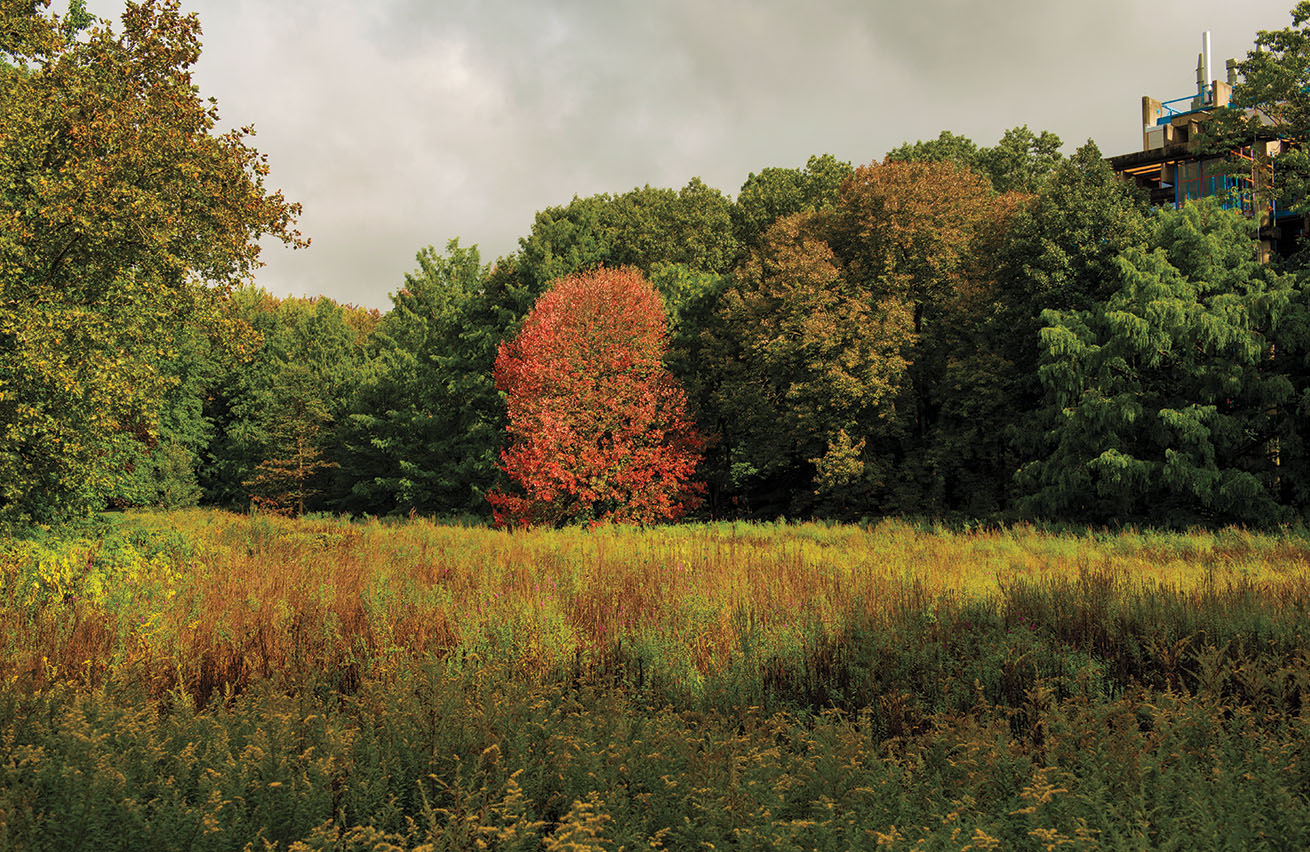
A view from College Road: A maple flames color along the edge of the Science Center meadow.
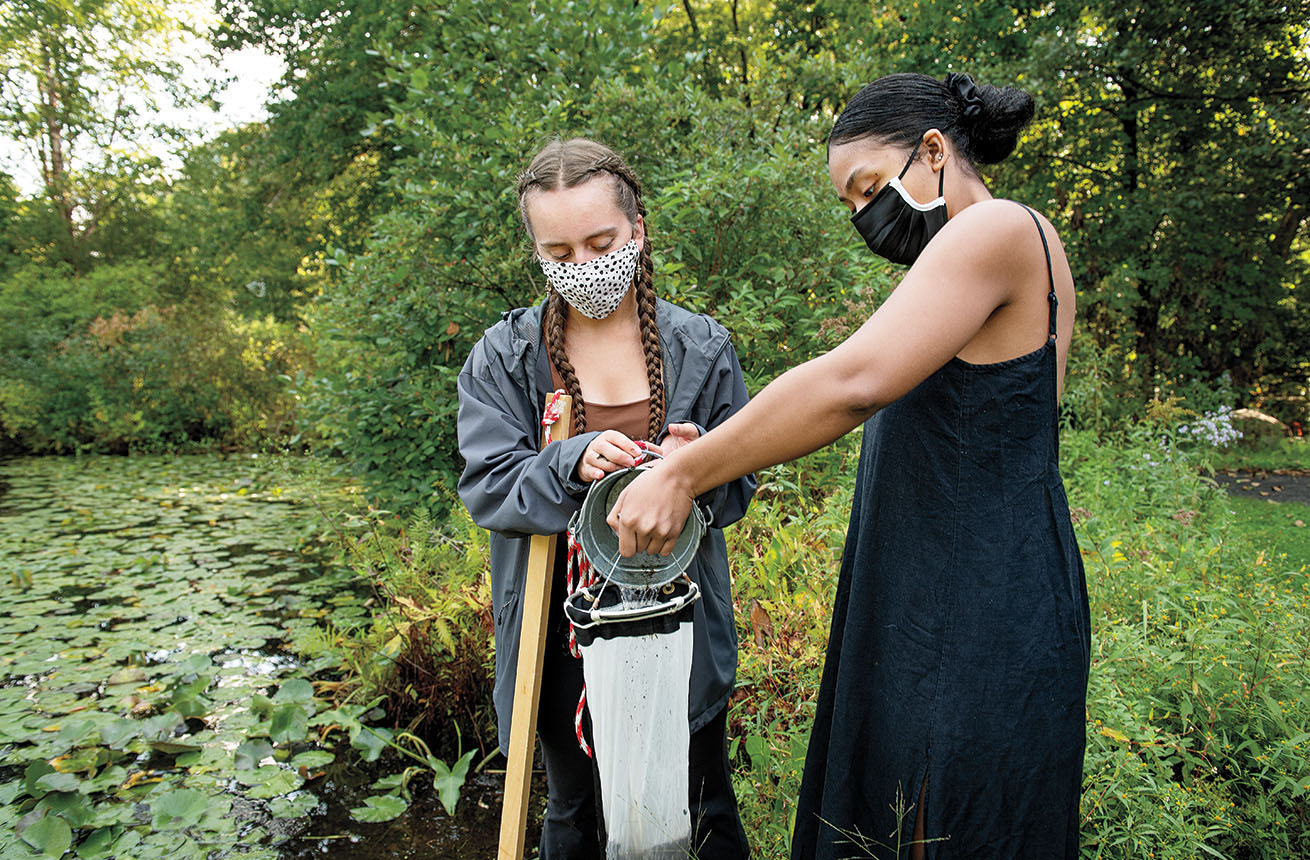
Paramecium Pond: Lily Marynik ’25 (left) and Genesis Vazquez ’23 collect plankton samples during a lab for Introductory Organismal Biology.
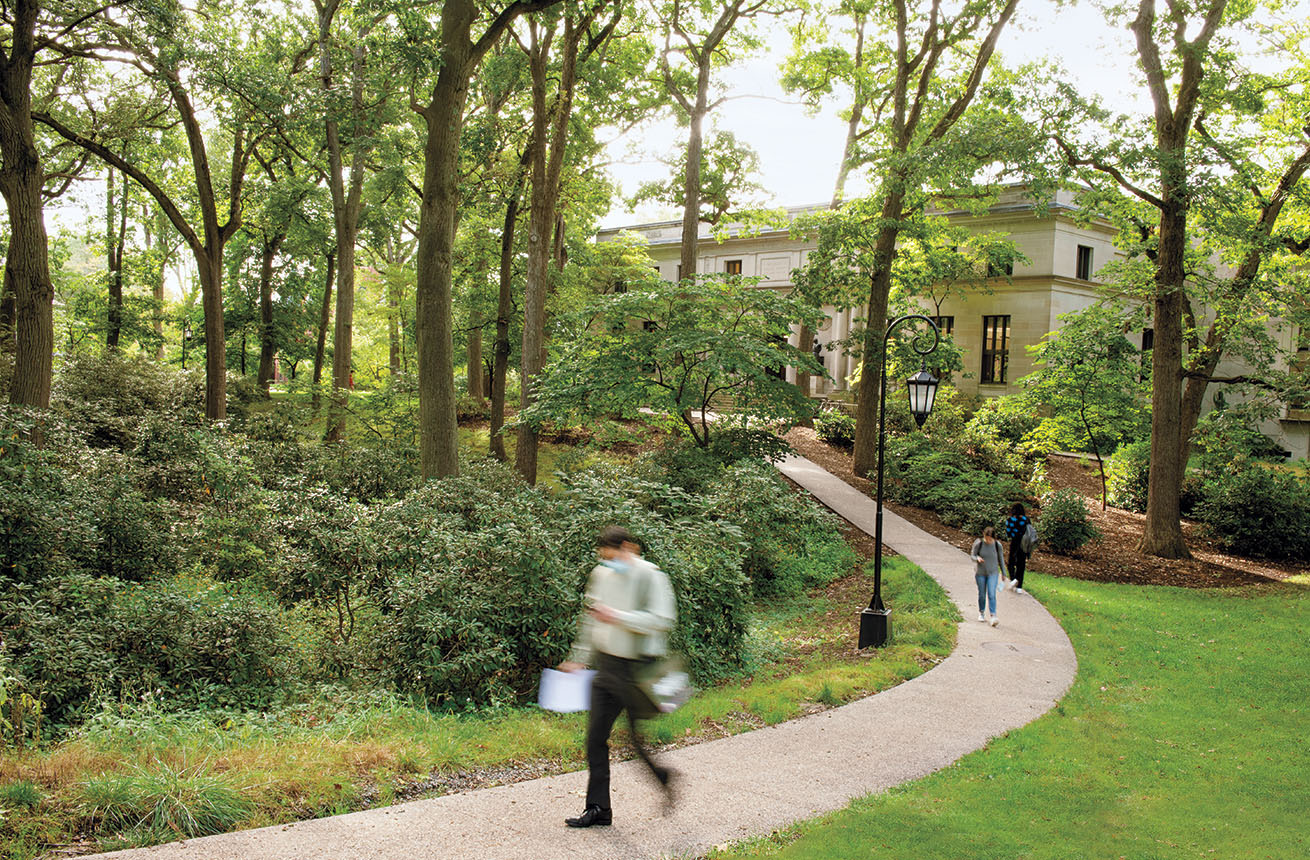
The path to Clapp Library: A curving walkway offers a ramble alongside Rhododendron Hollow.
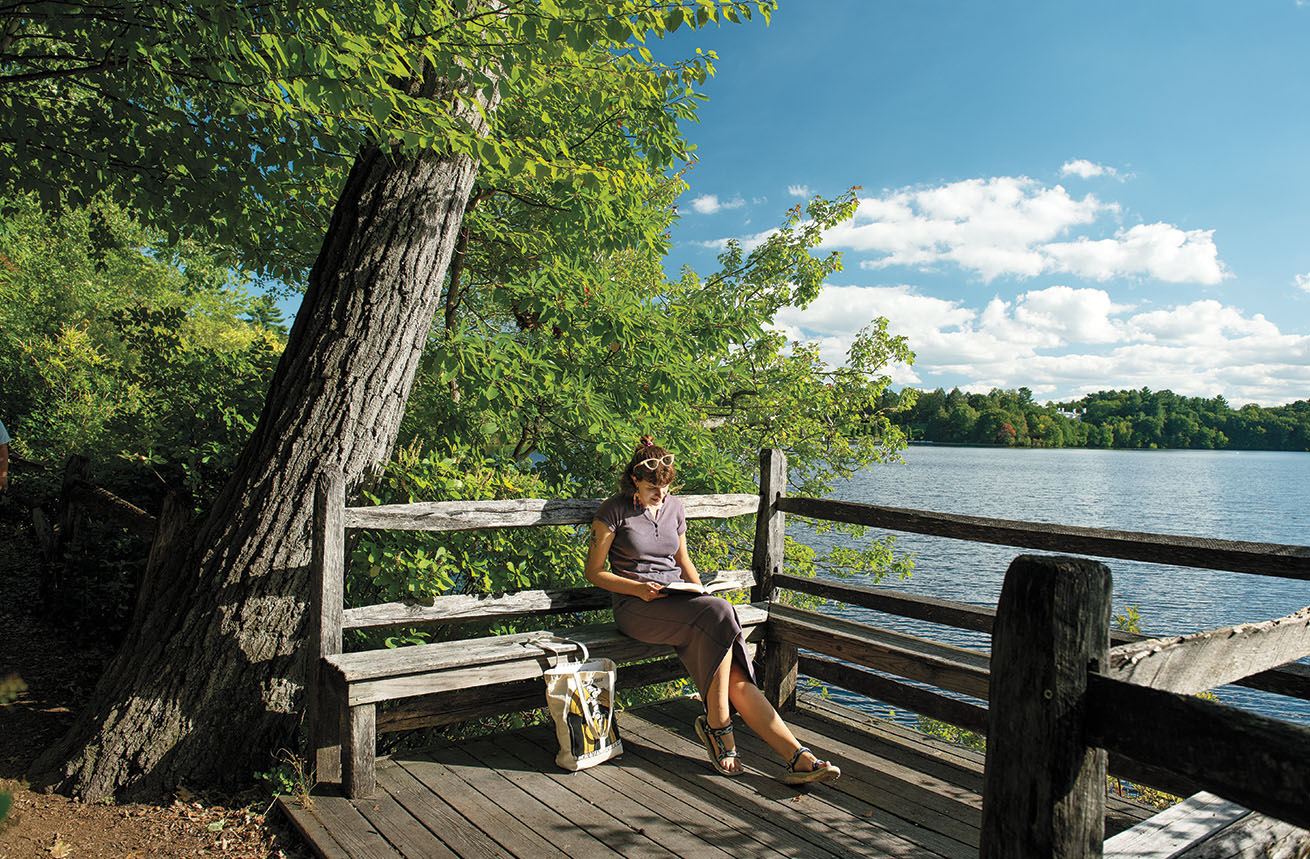
A “spoonholder” along Lake Waban: Abby Martinage ’24 enjoys a break in one of the lakeside balconies envisioned by founder Henry Durant.

A student walks by Lake Waban in September 2021.
Finding Home
Ecology means “the study of home,” and that is the Paulson Initiative’s mission. But for some Wellesley students, encountering the landscape can be complicated.
“Your identity can affect the way you see a specific space outdoors,” says Dayna De La Cruz ’21, who worked as a Paulson Initiative anti-racism ambassador. “If you’re an international student, you might not feel completely at home because you’re lacking the native plants that you’re used to.”
With Phoebe Shea Pérez ’23 and Jada Onwuta ’24, De La Cruz organized a weeklong Wintersession program in 2021 called “Redefining the Outdoors,” which focused on racial inclusivity and belonging in nature. The program addressed topics like how the participants’ identities shaped their experiences with the outdoors. There were discussions about who is seen as an “outdoors person” and who is excluded from those spaces. Green spaces that are comfortably accessible to the privileged can feel off-limits to people of color, and the ambassadors seek to break down those barriers.
De La Cruz recently bumped up against a personal experience of this kind of complexity. “I got a job offer to work at a company in California, where I’d be providing pollination services to farmers in the area to potentially increase crop yield and address food insecurity,” she says. “Farms are lovely, and they can be such pleasant and fruitful environments. But then I thought about how my family has a history of working and picking crops, being paid almost nothing, and surrounded by very dangerous pesticides. [Through] that lens, it was hard to have the same view.”
Despite that discomfort, De La Cruz plans to take the job in California, and she hopes to apply to graduate school in an environmental field in the future. Though she grew up in an urban environment in Houston, her time at Wellesley honed her deep love of the landscape and her commitment to protecting it.
“Land is not meant to be owned,” she says. “We should have a symbiotic relationship with the land, and not a parasitic ownership. It’s borrowed.”
The question of land ownership has been very much on the minds of the Wellesley student body. Long before founders Henry and Pauline Durant pieced together a collection of subsistence farms to create Wellesley’s campus in 1870, the land was home to Indigenous peoples. In May, Kimimilasha “Kisha” James ’21, then president of the Native American Student Association, offered the first public acknowledgement of this fact that had been made at commencment. And this October, the Wellesley College Board of Trustees voted on its first land acknowledgement, approving this statement:
“We acknowledge that Wellesley College is built on ancestral and traditional land of the Massachusett people. We also recognize that the United States’ removal, termination, and assimilation policies and practices resulted in the forced settlement of Indigenous lands and the attempted erasure of Indigenous cultures and languages. We further acknowledge the oppression, injustices, and discrimination that Indigenous people have endured and that there is much work to be done on the important journey to reconciliation. We commit to strengthen our understanding of the history and contemporary lives of Indigenous peoples and to steward this land.
“We further recognize the many Indigenous people living here today—including the Massachusett, Wampanoag, and Nipmuc nations—who have rich ancestral histories in Wellesley and its surrounding communities. Today, their descendants remind us that they are still here, where they maintain a vital and visible presence. We honor and respect the enduring relationship between these peoples and this land, as well as the strength of Indigenous culture and knowledge, the continued existence of tribal sovereignty, and the principle of tribal self-determination.”
Finding Joy
Bindu Nicholson ’16 was a post-baccalaureate fellow with the Paulson Initiative from 2019 to 2021, designing activities to connect students to nature and landscape. “My job was trying to get students to pay attention, to walk slowly, to pause, to say hello to trees and birds and frogs who live in the Wellesley community with us, getting to know their names, getting to know a little bit about them,” she says.
Nicholson says that one of the initiative’s goals is for the Wellesley community to develop empathy for the natural world. “I think the more we know about the natural world, the more we’ll want to take care of it, especially in these times of climate change,” she says.
For one activity, Nicholson led students to the Wellesley College Botanic Gardens. “We would go to sit spots,” she says. “For 10 minutes, we would just sit in a place that we chose. And we’d do this weekly. And we just observed the things around us, trying to be mindful in terms of being in the present, and trying to let go of other thoughts that are coming through, and just focus on what we’re seeing.” After those 10 minutes, she’d have the students respond to some type of prompt, such as, “Write a letter to yourself, write a letter to your future self about your sit spot.”
“One of the central things about being a residential college is having the opportunity to learn from your backyard. And to have this landscape as your backyard for four years is an incredible opportunity.”
—Kristina Niovi Jones, director of the Wellesley College Botanic Gardens


Edible Ecosystem: Teaching Garden Rohini Narayanan ’25 harvests ground cherries.
Finding Knowledge
“One of the central things about being a residential college is having the opportunity to learn from your backyard,” says Kristina Niovi Jones. “And to have this landscape as your backyard for four years is an incredible opportunity.”
Each year, faculty head outdoors to take advantage of the landscape. Dan Brabander, Frost Professor in Environmental Science and professor of geosciences, says his department asks, “How do we instill an appreciation of how unique this landscape is?”
“It is worth thinking creatively about how we preserve the features in our landscape, both from a climate perspective and also from the perspective of teaching, research, and connection,” he says. “During COVID, one of the fascinating things that we learned—and this was a really good lesson for us in geoscience—is it doesn’t need to be fancy to be ‘wow.’ I think we get infatuated with going to a front range in Colorado, or even as far as New Zealand, when we can just walk across the other side of Lake Waban and really take a look at an esker, [a ridge of sand, gravel, and boulders deposited by a glacier] and ask questions about the processes that caused this landform. There was a mile and a half of ice sitting here 12,000 years ago, and in geology, 12,000 years ago is like yesterday.”
Brabander would like to see a greater cross-section of the Wellesley community become connected to the landscape in a wider range of ways. “We talk about the beauty and the aesthetic,” he says. “But we can use the landscape in a liberal arts/transdisciplinary kind of way, where you ask questions as well as appreciate. And that’s a great gift. That’s what got me interested in geosciences: Why are these trees here? How is that related to the soil? The question-asking, that’s the key thing.”
Andrew Mowbray, lecturer in art, has taken to using the campus landscape as a resource for art making. “In my own practice, I’ve been questioning the materials I use around issues of sustainability and climate change,” he says. “That’s also what the students want.”
With his students, Mowbray constructed an archway using winter-killed bamboo that now serves as an entryway to the Edible Ecosystem Teaching Garden. They have crafted birdhouses from leftover wooden pallets, built stepped benches on Severance Green using wood from a fallen tree. They devised 3D sculptures using the invasive phragmites that grow in the meadows along College Road, and placed them next to the Mozart III sculpture by Kenneth Snelson near the Science Center.
“When we did the piece around Mozart III, it was an opportunity to have free materials from the phragmites, but also to talk about what is invasive, what can be done with these materials? From a design perspective, kind of thinking outside of the box, we asked, how can we make this into a positive thing,” Mowbray says.
Heather Corbally Bryant, a poet and a lecturer in the writing program, says the Wellesley landscape is a place of “rejuvenation and connection” for her and her students. It played a central role in her class You Are Not Here: Writing in the Distracted Age. “My idea for the class came out of watching students walking around campus buried in their phones,” she says. “I wanted them to look up. That’s really what this class was all about.”
Bryant says her students spent a lot of time examining their physical surroundings. “We would often go out of the classroom and find a spot on campus and do some impromptu writing down by the lake or in the Academic Quad,” she says. “We would just go out into the landscape. And a bunch of students started doing that practice on their own, outside of the class.”
They toured meadows and learned the names of trees. Students picked a landscape feature and wrote a poem about it. “They got invested in their particular tree or spot of expanse of grass,” Bryant says. “Probably the most lasting thing we did was to take part of their poem or some of the writing that they’d done and paint the words on a rock. And we hid the rocks in the botanic gardens area.”
Finding Connection and Community
As the new Science Center nears its opening date, a Science Hill landscape master planning project is underway. The project, a partnership among Facilities Management, the Paulson Initiative, and the botanic gardens, with extensive community input, will involve plans to restore the 43 acres comprising the Science Hill landscape. The goal is to provide resiliency in the face of climate change, cultivate a sense of belonging for all students, create outdoor spaces for discovery and learning, and reopen that part of campus to everyone after the long disruption of construction.
“A landscape is memories, places, and values,” says Hannah Cho ’20, a former Paulson Initiative intern who works at architecture firm Sasaki, which has offices in Massachusetts, Colorado, and China. “Space is the literal, basically geographic location you are in, and the physical properties of that location. Memories are made there. The Wellesley landscape is full of meaning; it is a place to a lot of people, especially after graduating. The landscape is not just a landscape. It’s also the association with community that each of us alums has and carries with us.”
Perhaps one of those alums will come across a rock in the botanic gardens inscribed with a poem by a Wellesley student, bringing the connection full circle.
Catherine O’Neill Grace is senior associate editor of this magazine. Her “sit spot” is an Adirondack chair in the Harris Courtyard behind Green Hall, a place that used to be a parking lot, but is now where the first snowdrops appear each year.




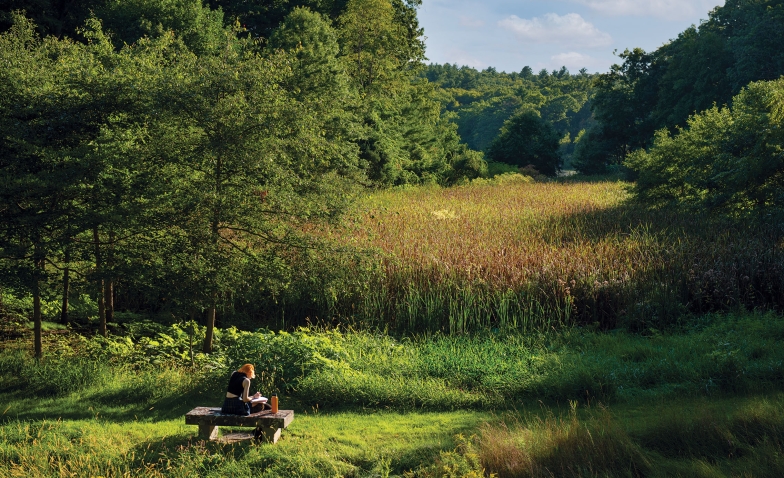








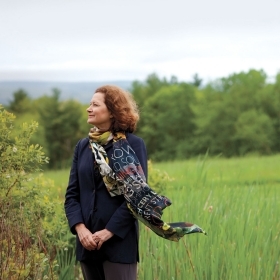
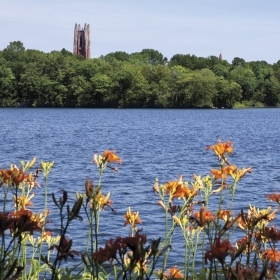
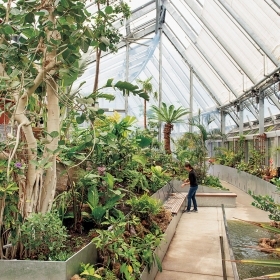
We ask that those who engage in Wellesley magazine's online community act with honesty, integrity, and respect. (Remember the honor code, alums?) We reserve the right to remove comments by impersonators or comments that are not civil and relevant to the subject at hand. By posting here, you are permitting Wellesley magazine to edit and republish your comment in all media. Please remember that all posts are public.